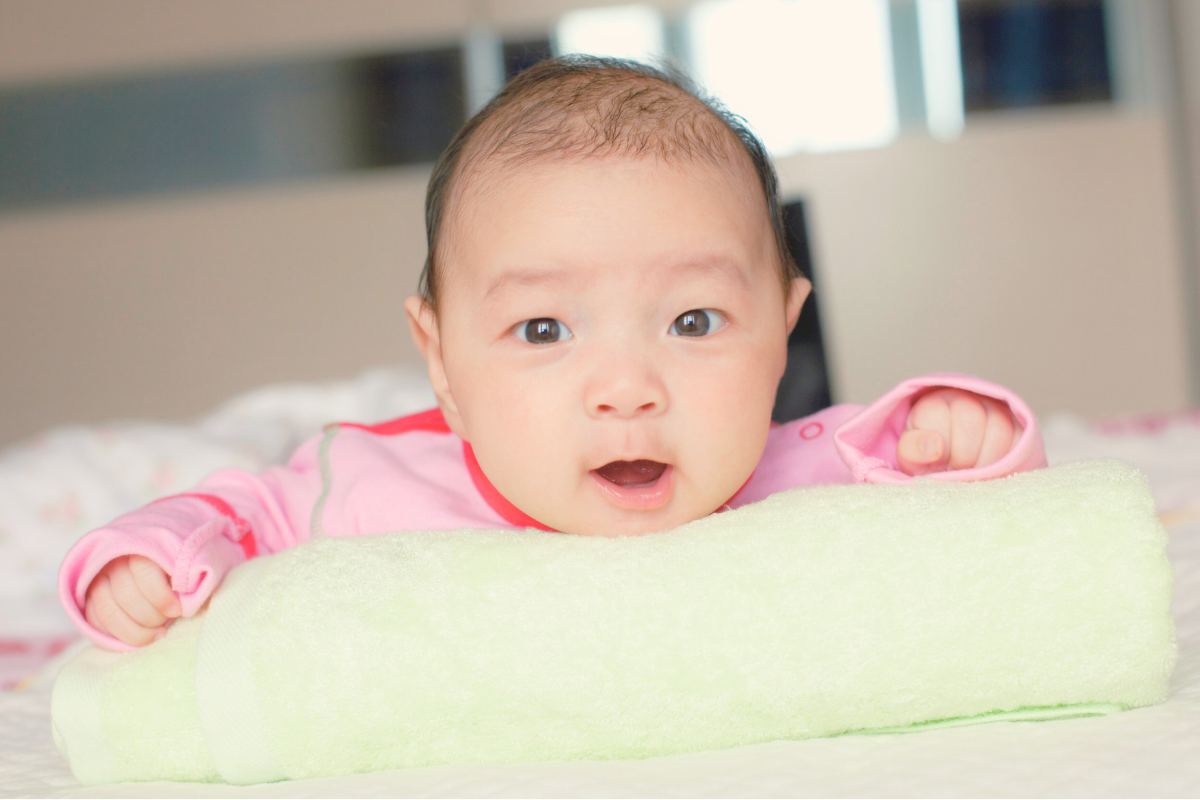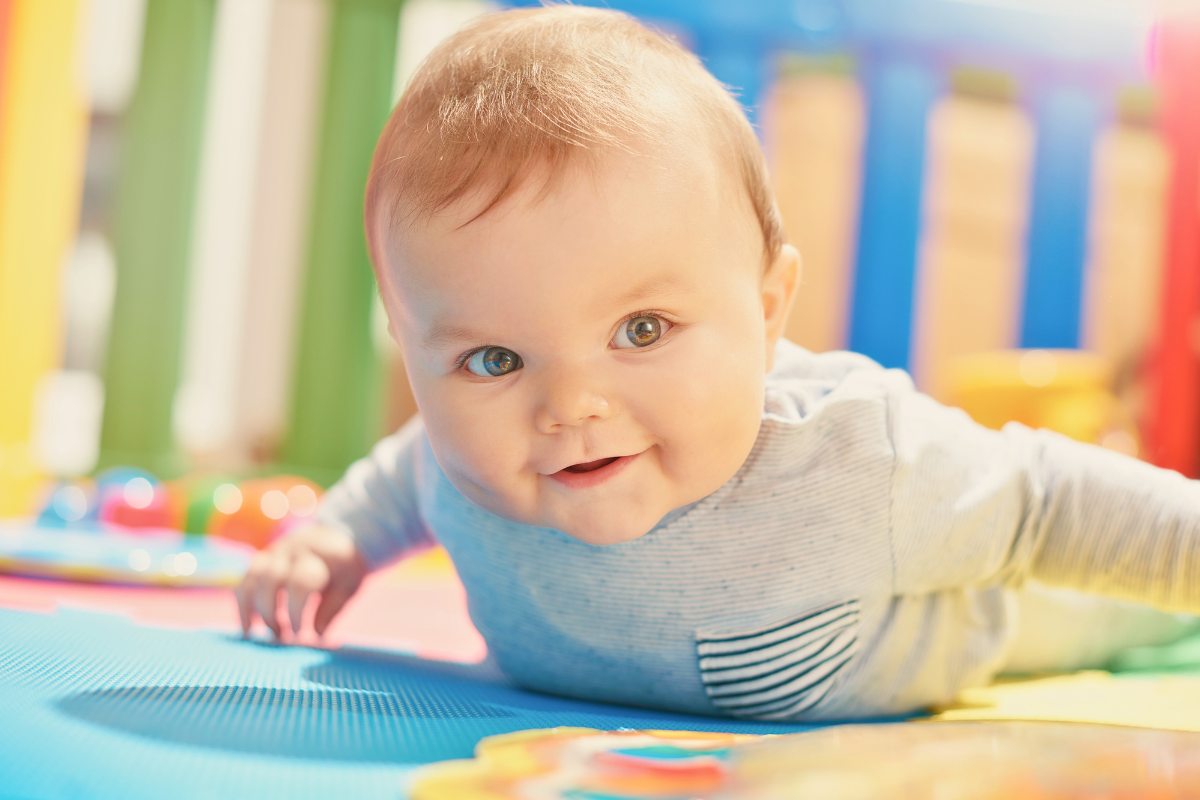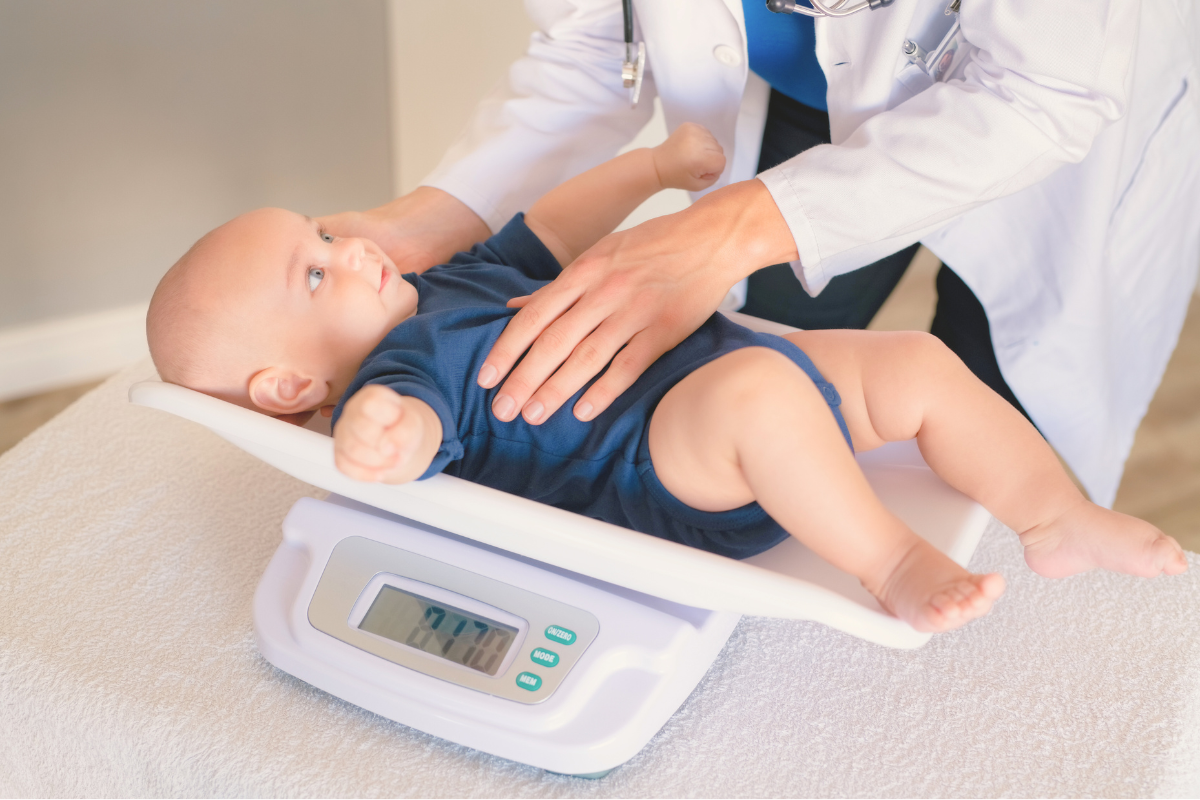When Can an Infant Roll Over? An Ultimate Guide
Parents often wonder, when can an infant roll over?
One of the most exciting moments for parents is seeing their babies roll over for the first time. Usually happening between 3 to 6 months, this milestone signals that your little one is starting to build the muscle strength they’ll need to explore more of the world around them.
Curious about when your baby might roll over, what to watch for, or how you can help your baby roll over? In this guide, we’ll walk you through the typical rolling timeline, give you tips for encouraging those first flips, and share when to reach out to your pediatrician. Get ready for all the wiggles and rolls ahead!
When Do Babies Start Rolling Over?

Watching your baby roll over for the first time is such an exciting moment for any parent.
So, how old are babies when they roll over? Rolling over often happens anywhere between 4 and 7 months. But according to experts like Dr. Jason M. Nagata, an award-winning pediatrician at the Benioff Children's Hospital in California, this “rolling over” milestone, like other developmental achievements, could happen at a different time for an individual baby.
For instance, although it’s unlikely for a baby to begin rolling over before 4 months, it doesn’t mean it’s impossible – some babies are known to start rolling over as early as 3 months. And looking at it from the opposite perspective, don’t be disappointed if your baby is not rolling over at 6, 7, or 8 months because every baby develops differently.
So, if your little one hasn't started yet, be patient – there’s still time.
Tummy to Back vs Back to Tummy
There are two main types of rolls that you'll see in your baby.
The first one is tummy to back or roll over from tummy. Since this movement relies more on gravity, it’s easier for most babies and typically happens between 4 to 6 months—though some eager little ones might pull it off as early as 3 months.
When babies lift their heads and chests during tummy time, they’re strengthening their neck and upper body muscles, getting ready for this exciting move. By 5 months, many babies are already pros at rolling from tummy to back.
Now, rolling from back to tummy is a whole different ball game.
Babies rolling this way tend to be more advance. The move is quite challenging because it takes real coordination. Think rocking back and forth, twisting those legs, and engaging the core. This milestone often occurs between 5 and 7 months. You’ll probably notice your baby getting more active during this time, rocking on their stomach, kicking their legs, and prepping for that all-important roll.
When your baby starts to show these signs, it’s a clear indicator they’re working on the muscles needed for that more complex back-to-tummy roll.
Baby Rolling Over Milestones

You might be wondering if your baby has begun rolling over too early or too late. Here's a more detailed timeline of when babies start rolling over.
Newborn to 2 Months: Laying the Foundation
During these early months, babies are working on basic reflexes and muscle control.
You can already start tummy time starting the first few weeks. This is super important for your baby's development, even if it's just a few minutes a day. It helps them start lifting their head and strengthening those tiny neck and shoulder muscles, getting them ready for rolling over soon.
3 to 4 Months: Building Strength
Around this time, babies begin to hold their heads up better and can push up on their arms during tummy time.
This is the early stage of rolling from their back to belly or tummy to back. These little “mini push-ups” are a sure sign your baby is gearing up to make that first flip!
5 to 6 Months: Achieving Mobility
Between 5 to 6 months, many babies learn to roll both ways – from tummy to belly to back and back to tummy.
This is when things start to get exciting! Rolling helps them strengthen their muscles and improves hand-eye coordination, which will be super useful for future milestones like crawling.
7 to 9 Months: Preparing for Crawling
Rolling is like the warm-up for crawling. The movements involved, like shifting their weight and pushing off the ground, are what help babies get strong enough to start crawling.
You also might notice them rocking back and forth – this is a big clue they’re getting ready for even more movement.
10 to 12 Months: Beyond Rolling Over
By this stage, rolling is old news. Babies who have mastered it are probably moving on to standing, pulling themselves up, and maybe even taking a few steps.
Rolling over plays a huge part in helping them build the strength they’ll need for walking and other milestones that come next.
Signs Your Baby Is Ready to Roll Over
As your baby approaches the milestone of rolling over, you'll likely notice them building strength and coordination in a few key areas. The head, neck, arms, and core muscles all work together to help them reach this exciting milestone.
Here’s a breakdown of what this looks like.
Lifting Head and Chest
One of the first signs your baby is getting ready to roll is early head movements, which is one of the tummy time milestones you should watch out for.
Lifting their head and chest during tummy time or floor time strengthens their neck and shoulders, helping them gain control over their upper body. Each time they lift their arm muscles above their head, they’re one step closer to rolling.
It may start small – ifting their head for just a few seconds – but over time, they’ll be able to hold it longer and higher. These little “mini push-ups” are their way of preparing to flip, and it’s a big deal for their development.
Pushing with Arms

Pushing up with their arms is another strong indicator that rolling is on the horizon. When babies press their hands into the ground during tummy time, they’re building the muscles they need for rolling from tummy to back. Their chest, arms, and shoulders all benefit from this movement.
At first, they may use their forearms, but they’ll soon start pressing up with their hands. Placing toys just out of reach can encourage them to push up higher and build even more strength for that first roll.
Kicking and Twisting Legs
Don’t forget about the legs! Kicking and twisting are key movements that help babies shift their weight and coordinate their bodies. These motions are especially important when they’re getting ready to roll from back to tummy.
If you see them grabbing their feet or twisting their legs while lying on their back, that’s a great sign they’re practicing for rolling. Gentle games that involve side-to-side movement can help them understand how to use their legs to assist in rolling.
Other Signs to Watch For
-
Turning their head to track objects or people. This shows their neck muscles are developing.
-
Reaching forward for toys. They’re working on balance and coordination.
-
Tucking their arms during tummy time. Pushing up on their forearms means they’re building up to a roll.
Each sign points to the exciting moment when they’ll finally be able to roll over! Celebrate these small victories, and keep encouraging your baby with fun, interactive playtime.
How to Encourage Your Baby to Roll Over
Helping your baby learn to roll over is an exciting part of their development! With a few simple strategies and fun activities, you can help encourage rolling and support them in mastering this milestone.
Maximize Tummy Time
Tummy time is one of the best ways to build the strength your baby needs to roll. Start with short, frequent sessions, and gradually increase the time as your baby’s muscles get stronger.
-
Make it engaging. Get down on the floor with your baby during tummy time! Try making funny faces, using a mirror, or talking to them to hold their attention. These activities can make baby's tummy time more fun and encourage rolling as they lift their head to interact with you.
-
Use toys. Place bright, colorful toys just out of your baby's reach to get them to lift themselves. This movement helps strengthen their arms and neck control, which is essential for rolling. We recommend the Poppyseed Play Baby Gym, which comes with the fun toys that will definitely motivate your child to reach forward.
-
Give a little support. If they need extra help, you can tuck a small, rolled towel under their chest to give a boost. This helps rolling babies develop the necessary strength to push up and eventually flip over.

Tummy time not only supports early rolls but also prepares your baby for sitting, crawling, and other milestones.
For the best experience during tummy time, consider using a baby-safe mat, like the Poppyseed Play Padded Mat or the Poppyseed Play Linen Play Mat.
Engage in Interactive Play
Turn playtime into an opportunity to encourage rolling! Placing toys slightly out of reach prompts your baby to stretch, roll, and engage with their surroundings. This helps build both physical strength and coordination.
-
Turn it into a fun game. Slowly move toys across their line of sight to encourage them to follow with their eyes and body. Most babies enjoy this type of interactive play, and it helps develop the coordination needed to roll.
-
Praise their efforts. Celebrate every small attempt with excitement! Even if they don’t completely roll, cheering them on boosts their confidence and makes the process fun. Babies love this kind of positive feedback.
This interactive play helps strengthen your baby's muscles and improves their balance and motor skills, making each small move a step toward rolling.
Offer Positive Reinforcement

Babies thrive on encouragement, and giving them plenty of praise during their rolling practice can help them stay motivated. Celebrate every small movement with enthusiasm!
-
Celebrate each effort. Clap, smile, and show your excitement for every tiny move your baby makes. Whether it's lifting their head or starting to roll, your encouragement makes rolling something your baby will want to practice more often.
-
Make it fun. Turn every roll attempt into a fun game by laughing, cheering, and engaging with your baby. Your energy will make them eager to keep trying new movements. Most babies respond positively to this kind of enthusiasm, making practice sessions a bonding experience.
Keep in mind that never leaving your baby unattended during these play sessions is important. Positive reinforcement creates a joyful environment around rolling, building their confidence while helping them develop the neck and body control needed for rolling over.
How to Keep Babies Safe When Rolling Over
Watching your baby roll over is an exciting milestone! But as they start moving around more, it's time to think about safety. Once your rolling baby is on the move, it’s important to make sure their environment is safe for both play and sleep.
Basic Guidelines to Keep Babies Safe
Here are some important tips to keep in mind when your baby starts rolling.
-
Always supervise. Whether they’re on a bed, changing table, or the floor, keeping an eye on your baby is a must. Babies can roll in the blink of an eye, and even a quick turn could result in a fall from a high surface. Always have a hand on them, especially during diaper changes.
-
Babyproof your home. Now that rolling is in the mix, it’s time to secure heavy furniture, cover outlets, and remove small objects within reach that could be a choking hazard. This step helps keep your home safe for baby development while they explore their surroundings.
-
Stop swaddling. When babies show signs of rolling, it’s time to stop swaddling and switch to a sleep sack. A sleep sack gives your rolling baby more freedom to move without getting tangled, which makes it a much safer option for sleep.
-
Switch to a crib. If your baby is still in a bassinet by 4 months, it’s time to move them to a baby's crib. Cribs provide more space and keep them safer as they grow, especially as babies sit and roll more frequently. Make sure you choose the right crib mattress for them, too!
-
Watch pets closely. Pets and babies are cute together, but a baby rolling onto a pet can lead to an unexpected reaction. Make sure to supervise any interactions to keep both your baby and pet safe during playtime.
How to Keep Babies Safe During Sleep
As soon as babies start rolling, sleep safety becomes even more important.
If your baby rolls onto their tummy during the night, it can increase the risk of Sudden Infant Death Syndrome (SIDS). Here’s how you can keep your baby's crib a safer space.
-
Stop swaddling. Babies who roll in their sleep need more freedom to move, and swaddling can become a hazard. Switching to a sleep sack allows them to move safely while keeping them warm.
-
Always place them on their back. The American Academy of Pediatrics (AAP) advises that placing your baby on their back to sleep is safest. Even if they roll during the night, starting them on their back helps reduce risks related to SIDS.
-
Keep the crib clear. Remove pillows, blankets, and stuffed animals from the baby's crib to avoid suffocation risks. A clutter-free crib means your baby can move around safely without getting caught in anything.
How to Babyproof Your Home

Now that rolling is part of your baby’s daily routine, it’s time to babyproof the house. A mobile baby can quickly find themselves in tricky situations, so here’s how to prepare your home:
-
Secure furniture. Attach heavy furniture like bookshelves and dressers to the wall. This keeps your baby's arm safe from accidents like tipping furniture as they explore.
-
Cover electrical outlets. Babies are naturally curious, and small fingers tend to find outlets fascinating. Use outlet covers to keep them safe from electrical hazards.
-
Remove choking hazards. Anything small enough to fit in your baby’s mouth should be removed from their reach. Always check areas where your rolling baby might end up, such as under furniture or tight spaces, for small objects.
-
Install safety gates. Block off any areas where rolling could lead to a fall, like stairs. Sturdy gates help keep your baby’s play area safe.
-
Never leave them unattended on changing tables. Babies can roll quickly, so always keep one hand on them during diaper changes. Even a brief moment unattended can lead to a fall, so stay close at all times.
By staying a step ahead, you’re helping create a space where you can keep your baby safe as well as let them explore their new skills with confidence.
My Baby Isn't Rolling Over, Why?
If your baby hasn’t started rolling yet, don’t stress—babies grow at their own speed. While many little ones begin rolling between 4 and 6 months, some take a bit longer, and that’s perfectly okay! Development isn’t a race, and a late start doesn’t necessarily mean anything is wrong.
We’ll dive into why this might be happening, but rest assured, in many cases, it’s just a matter of time before your baby hits this exciting milestone.
Factors That Can Influence Rolling Over
There are many reasons your baby might not be rolling over yet. Let’s take a closer look at some of the factors that can play a role.
-
Baby's environment. The space where your baby spends time can make a big difference. Babies who have open, stimulating areas to move and explore often reach milestones like rolling a bit sooner. A safe, roomy play area encourages movement and makes practice fun.
-
Opportunities for tummy time. Regular tummy time is a great way to help your baby develop the muscles they need for rolling. Research shows that babies who get daily tummy time are more likely to hit motor skill milestones earlier. Short, frequent sessions throughout the day are a good way to build strength.
-
Overall muscle development. Every baby’s muscle strength develops at its own pace. Some babies may just need more time to build up their neck, arm, and core muscles for upper body strength before they’re ready to roll. This varies from baby to baby, so a delay in rolling isn’t necessarily a cause for concern.
-
Time spent on their back. Babies who spend a lot of time on their backs without the chance to practice tummy time may roll later. While it’s important to follow safe sleep guidelines and put your baby to sleep on their back, making time for tummy time during the day helps balance it out.
-
Temperament and personality. Some babies are just naturally more relaxed! If your little one seems content watching the world from one spot, they may take longer to roll. Personality can have a big influence on when babies hit their physical milestones.
When to Consult a Pediatrician

Authorities on the subject, like the Center for Disease Control (CDC) and the AAP, offer guidelines on baby milestones, including when babies typically begin rolling, sitting, and crawling.
While most delays in milestones like rolling aren’t a big deal, there are a few signs that mean it’s worth checking in with your pediatrician.
-
Lack of interest in movement. Babies are naturally curious and love to explore, so if your baby doesn’t seem interested in moving at all by 6 months, it might be a good idea to talk to your doctor. They can help determine if there’s anything that needs further attention.
-
Difficulty with head control. Babies should be able to hold their head up steadily during tummy time by around 4 months. If they’re still struggling with head control beyond that, it’s something worth discussing, as strong neck muscles are key for rolling.
-
Stiff or floppy muscles. If your baby seems unusually stiff or floppy, it could be a sign of muscle tone issues. This could make rolling more difficult, and your pediatrician can help assess the situation.
-
Asymmetrical movements. If your baby only moves one side of their body or favors just the left arm or the right leg, it could be a sign that they’re having trouble with coordination. Babies should be using both sides of their body equally.
-
Limited response to stimuli. Babies should respond to sounds, sights, and movement. If your baby isn’t turning their head towards noises or tracking objects with their eyes, it’s a good idea to bring it up with your pediatrician.
If your baby hasn’t started rolling or shown other signs of mobility like sitting up or crawling by 12 months, it’s time to check in with your doctor. Early intervention is always helpful if there are developmental delays.
Next Milestones After Rolling Over

Congratulations – your baby has mastered rolling over! But the fun is just getting started. Rolling sets the stage for a whole series of exciting developmental milestones. Let’s take a quick look at what’s next.
Sitting Up
-
New perspective. After rolling, many babies start learning how to get to a sitting position on their own, usually between 6 to 8 months. This allows them to explore the world in a new way.
-
Building balance. Sitting independently helps babies develop core strength and balance, skills they first practiced while rolling.
Crawling
-
On the move. Crawling often begins between 7 to 10 months. Your baby will use the muscles they built while rolling to start exploring their environment.
-
Different styles. Some babies crawl on their bellies or scoot on their bottoms, but all methods help them build coordination for standing.
Pulling Up to Stand
-
Gaining strength. Around 9 to 12 months, babies start pulling themselves up using furniture or your legs.
-
Cruising. Once they’re standing, many babies "cruise" along furniture, building leg strength and balance in preparation for walking.
Walking
-
First steps. Walking usually follows standing, typically around their first birthday. These first wobbly steps are exciting and mark a major milestone in their growing independence.
Final Thoughts
Watching your baby learn to roll over is such an exciting milestone, and with the right support, they'll soon be moving on to the next stages of their development.
By creating a safe environment, engaging in tummy time, and offering encouragement, you're helping your baby grow stronger and more confident with each new skill!
Frequently Asked Questions
When should I be concerned if my baby isn't rolling over?
If your baby hasn’t started rolling over by 6 months, it’s a good idea to talk with your pediatrician. Babies grow at their own pace, but your doctor can check on your baby’s growth and give you peace of mind or suggest next steps if needed.
Is it safe for my baby to sleep on their stomach once they can roll over?
Yes, once your baby can roll independently in both directions, it’s safe for them to sleep on their stomach. Just make sure you always put them down on their back first and keep their crib free from any loose objects like blankets or pillows.
When do most babies sit up on their own?
Most babies start sitting independently between 6 and 8 months. The strength they built while learning to roll helps them stay balanced when they begin to baby sit. Every baby is different, so it may happen earlier or later.
Should I stop swaddling my baby when they start showing signs of rolling over?
Yes, stop swaddling as soon as your baby shows signs of rolling. Swaddling restricts movement, and a rolling baby needs the freedom to move safely. Switch to a sleep sack to allow more flexibility.
What comes after rolling over?
After rolling, babies usually move on to sitting independently, crawling, and eventually standing and walking. These milestones are part of baby's growth, and each one builds on the skills they’ve learned while rolling.
My baby is rolling over but suddenly stopped?
It can be concerning if your baby stopped rolling over all of a sudden after already learning how to. That said, we recommend observing their other milestones. After all, maybe they're just ready for the next milestone. If all the other milestones have stopped coming though, it might be best to check with a pediatrician.




